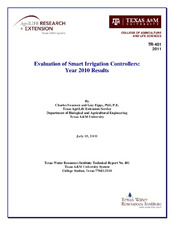| dc.description.abstract | A smart controller testing facility was established by the Irrigation Technology Center at Texas A&M University in College Station in 2008 in order to evaluate their performance from an “enduser” point of view. The “end-user” is considered to be the landscape or irrigation professional (such as a Licensed Irrigator in Texas) installing the controller. Controllers are tested using the Texas Virtual Landscape which is composed of 6 different zones with varying plant materials, soil types and depths, and precipitation rates.
This report summaries the results from the 2010 evaluations. Eight controllers were evaluated over a 238 day period, from March 29 - November 22, 2010. Controller performance is analyzed for the entire evaluation period as well as seasonally (spring, summer, fall). Controller performance is evaluated by comparison to the irrigation recommendation of the TexasET Network and Website. This year, we introduce a new evaluate methodology: irrigation adequacy in order to identify controllers which apply excessive and inadequate amounts of water.
Programing smart controllers for specific site conditions continues to be a problem. Only two (2) of the eight (8) controllers tested could be programmed directly with all the parameters needed to define each zone.
The 2010 results showed an increase in controller performance compared to the Year One and Year Two results. However, we continue to see controllers irrigating excessively; some irrigated in excess of ETc even though 17 inches of rainfall fell during the study.
Total Irrigation Amounts
* When looking at total irrigation amounts for the entire landscape, one (1) controller was within +/- 20% the recommendation of the TexasET Network for five (5) stations
* Two (2) controllers applied greater than a simple ETc model (ETo x Kc, neglecting rainfall) and one (1) controller was greater than ETo.
Adequacy Analysis
* No controllers were consistently able (across all 6 stations) to adequately meet the plant water requirements throughout the entire season.
* The results showed inconsistency in performance by the 8 controllers, with three (3) controllers irrigating excessive volumes and four (4) controllers irrigating inadequate volumes.
* Two (2) controllers had five (5) stations irrigate adequate amounts and two (2) controllers had four (4) stations irrigate adequate amounts.
Factors that could have caused over/under irrigation of landscapes are improper ETo calculations and insufficient accounting for rainfall. Only three (3) controllers were equipped with “tipping bucket” type rain gauges which actually measure rainfall. Two of these were consistency among the top 3 performing controllers.
Based on 2010 performance, controllers which used onsite sensors for ET calculations irrigated closer to the recommendations of the TexasET Network than those which operate on an ET subscription. It was observed that controllers that used on site sensors more often produced inadequate irrigation amounts compared to ET subscription controllers that generally produced excessive irrigation amounts. | en |


